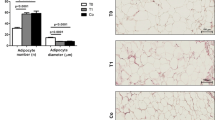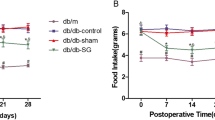Abstract
Background
There is accumulating agreement that bariatric surgery is currently the most efficacious and enduring treatment for clinically severe obesity, and as a result, the number of bariatric surgeries performed worldwide has increased in recent years. Although the function of visceral fat has gradually become clear, the effect of visceral fat resection is still unknown. The aim of this study was to clarify the additional effect of visceral fat resection in an obese rat model of gastric banding.
Methods
Forty male Zucker fatty rats were divided into four groups: the control group, visceral fat resection group, gastric banding group, and gastric banding with visceral fat resection group. They were followed for 8 weeks after surgery, and their body weight change, cumulative food intake, metabolic parameters, and adipocytokines were measured.
Results
The gastric banding rats either with or without visceral fat resection showed significant decreases in weight gain, cumulative food intake, and levels of metabolic parameters compared to the control rats. There were no significant differences in weight gain and cumulative food intake between gastric banding with and without visceral fat resection. However, gastric banding with visceral fat resection resulted in lower plasma levels of free fatty acid and TNF-alpha compared to gastric banding alone, and expression of adiponectin mRNA in the adipose tissue was significantly decreased with the addition of visceral fat resection compared with banding alone. There were no significant differences in any parameters between controls and rats receiving visceral fat resection alone.
Conclusion
Visceral fat resection may improve adipocytokines and free fatty acid in an obese rat model of gastric banding. However, further studies are necessary before the procedure can be considered an option on bariatric surgery.







Similar content being viewed by others
References
Prentice AM. The emerging epidemic of obesity in developing countries. Int J Epidemiol. 2006;35:93–9.
World Health Organization. Obesity: preventing and managing the global epidemic. WHO Obesity Technical Report Series 894. Geneva, Switzerland: World Health Organization; 2000.
National Institute of Health. Gastrointestinal surgery for severe obesity. National Institutes of Health Consensus Development Conference Statement. Am J Clin Nutr. 1992;55:S615–S619.
Puzziferri N, Blankenship J, Wolfe BM. Surgical treatment of obesity. Endocrine. 2006;29:11–9.
Buchwald H, Williams SE. Bariatric surgery worldwide 2003. Obes Surg. 2004;14:1157–64.
Fujimoto WY, Bergstorm RW, Byoko EJ, et al. Visceral adiposity and incident coronary heart disease in Japanese-American men. The 10-year follow-up results of the Seattle Japanese-American Community Diabetes Study. Diabetes Care. 1999;22:1808–12.
Ferrannini E, Natali A, Capaldo B, et al. Insulin resistance, hyperinsulinemia, and blood pressure: role of age and obesity. European Group for the study of Insulin Resistance (EGIR). Hypertension. 1997;30:1144–9.
Barzilai N, She L, Liu BQ, et al. Surgical removal of visceral fat reverses hepatic insulin resistance. Diabetes. 1999;48:94–8.
Kim YW, Kim JY, Lee SK. Surgical removal of visceral fat decreases plasma free fatty acid and increases insulin sensitivity on liver and peripheral tissue in monosodium glutamate (MSG)-obese rats. J Korean Med Sci. 1999;14:539–45.
Gabriely I, Ma XH, Yang XM, et al. Removal of visceral fat prevents insulin resistance and glucose intolerance of aging: an adipokine-mediated process? Diabetes. 2002;51:2951–8.
Thörne A, Lönnqvist F, Apleman J, et al. A pilot study of long-term effects of a novel obesity treatment: omentectomy in connection with adjustable gastric banding. Int J Obes. 2002;26:193–9.
Santoro S, Malzoni CE, Velhote MC, et al. Digestive adaptation with intestinal reserve: a neuroendocrine-based operation for morbid obesity. Obes Surg. 2006;16:1371–9.
Endo Y, Ohta M, Kai S, et al. An obese rat model of bariatric surgery with gastric banding. Obes Surg. 2007;17:815–9.
Argiles JM. The obese Zucker rat: a choice for fat metabolism. Prog Lipid Res. 1989;28:53–66.
Phillips MS, Liu Q, Hammond HA, et al. Leptin receptor missense mutation in the fatty Zucker rat. Nat Genet. 1996;13:18–9.
Yamashita T, Murakami T, Iida M, et al. Leptin receptor of zucker fatty rat performs reduced signal transduction. Diabetes. 1997;46:1077–80.
Rubino F, Zizzari P, Tomasetto C, et al. The role of the small bowel in the regulation of circulating ghrelin levels and food intake in the obese zucker rat. Endocrinology. 2005;146:1745–51.
Pitombo C, Arújo EP, de Souza CT, et al. Amelioration of diet-induced diabetes mellitus by removal of visceral fat. J Endocrinol. 2006;191:699–706.
Mattews DR, Hosker JP, Rudenski AS, et al. Homeostasis model assesment: insulin resistance and β-cell function fasting plasma glucose and insulin concentration in man. Diabetologia. 1985;28:412–9.
Morino M, Toppino M, Forestieri P, et al. Mortality after bariatric surgery: analysis of 13,871 morbidly obese patients from a national registry. Ann Surg. 2007;246:1002–9.
Elder KA, Wolfe BM. Bariatric surgery: a review of procedures and outcomes. Gastroenterology. 2007;132:2253–71.
Buchwald H, Avidor Y, Braunwald E, et al. Bariatric surgery: a systemic review and meta-analysis. JAMA. 2004;292:1724–37.
Flum DR, Dellinger EP. Impact of gastric bypass operation on survival: a population-based analysis. J Am Coll Surg. 2004;199:543–51.
Fernandez AZ Jr, Demaria EJ, Tichansky DS, et al. Multivariate analysis of risk factors for death following gastric bypass for treatment of morbid obesity. Ann Surg. 2004;239:698–702.
Arita Y, Kihara S, Ouchi N, et al. Paradoxical decrease of an adipose-specific protein, adiponectin, in obesity. Biochem Biophys Res Commun. 1999;257:79–83.
Degawa-Yamauchi M, Moss KA, Bovenkerk JE, et al. Regulation of adiponectin expression in human adipocytes: effects of adiposity, Glucocorticoids, and tumor necrosis factor α. Obes Res. 2005;13:662–9.
Bruun JM, Lihn AS, Verdich C, et al. Regulation of adiponectin by adipose tissue-derived cytokines: in vivo investigations in humans. Am J Physiol Endocrinol Metab. 2003;285:E527–33.
Feldstein AE, Werneburg NW, Canbay A, et al. Free fatty acids promote hepatic lipotoxicity by stimulating TNF-α expression via a lysosomal pathway. Hepatology. 2004;40:185–94.
Author information
Authors and Affiliations
Corresponding author
Rights and permissions
About this article
Cite this article
Endo, Y., Ohta, M., Hirashita, T. et al. Additional Effect of Visceral Fat Resection in an Obese Rat Model of Gastric Banding. OBES SURG 19, 777–782 (2009). https://doi.org/10.1007/s11695-008-9613-9
Received:
Accepted:
Published:
Issue Date:
DOI: https://doi.org/10.1007/s11695-008-9613-9




